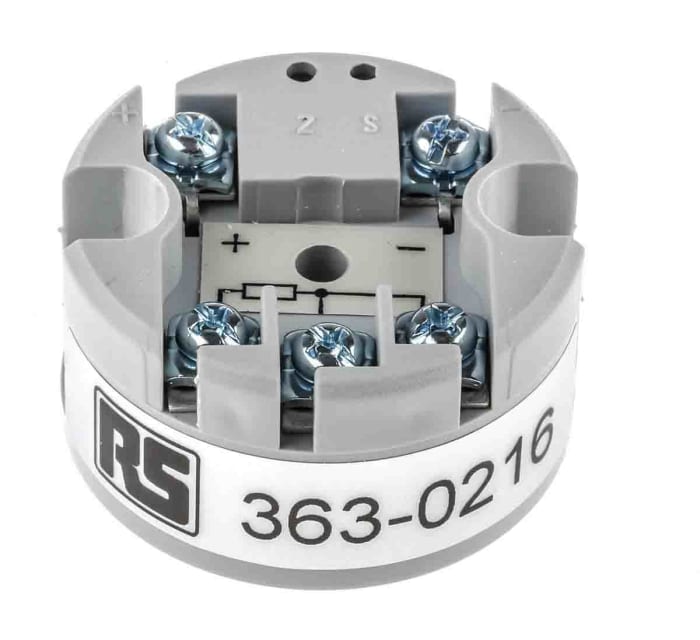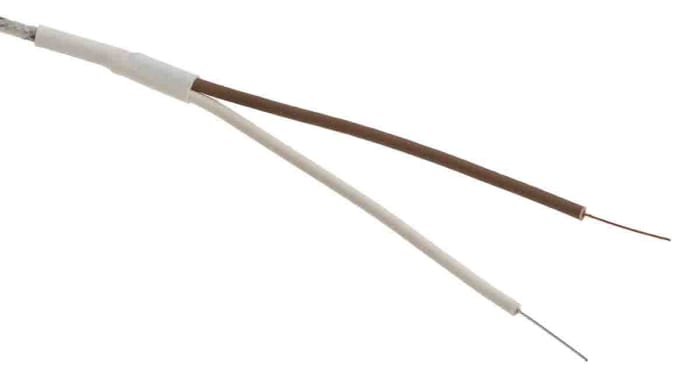RS PRO Type T Exposed Junction Thermocouple 1m Length, 1/0.2mm Diameter → +250°C

Technical Document
Specifications
Brand
RS ProThermocouple Type
T
Probe Diameter
1/0.2mm
Probe Length
1m
Probe Material
PTFE
Maximum Temperature Sensed
+250°C
Termination Type
Bare Wire Tail
Cable Length
1m
Standards Met
BS
Country of Origin
United Kingdom
Product details
RS Pro BS1843 Type K & Type T Exposed Junction Wire Thermocouple
From RS Pro type K and Type T thermocouple temperature sensors colour coded to the former British Standard – BS1843-1952 with a Class 1 tolerance in accordance with IEC 584-2 (formerly BS4937:1983) standards for optimum accuracy. These thermocouple temperature sensors feature a welded tip exposed junction for a fast response time. The leads have a durable PTFE insulation for resistance to oils, acids and other fluids
How does a Thermocouple Work?
A thermocouple is a sensor used to measure temperature in a range of different processes and consists of two wire legs made from different metals joined together at their two ends to form two junctions. The hot, or measuring junction is connected to the body whose temperature is going to be measured. The cold junction or reference junction is connected to a body of known temperature. When the measuring junction is placed on something hot a voltage or potential difference between this and the reference junction occurs. This voltage can then be converted into a temperature measurement using thermocouple reference tables. This process is also known as the Seebeck Effect
What is a Welded Exposed Junction?
In a welded grounded junction the two thermocouple wires and sheath are welded together to form one junction at the probe tip. These thermocouples have a fast response time because all the thermocouple is making contact with the sheath allowing the heat to transfer easily.
Features and Benefits
• Welded, exposed junction for fast response times
• IEC-584-2 Class 1 tolerance for optimum accuracy
• Durable PTFE lead insulation for resistance to oils, acid, fluids and good mechanical strength and flexibility
Applications
Exposed junction thermocouples are more prone to corrosion and are recommended for measuring flowing or static non-corrosive gas temperatures. Applications for these Type K and Type T thermocouples include test and development, test and measurement, temperature mapping and OEM applications.
Old Colour Code, BS1843
Thermocouples, bayonet adaptors, compensating and extension cables and connectors.,These BS1843 products are being phased out, having been replaced with a new colour code standard BS4937 Part 30 1993 (IEC 584-3 1989 modified for international use). System Calibration is available on selected probes and includes the full charge of the instrument and probe.
SR 148.85
SR 29.77 Each (In a Pack of 5) (ex VAT)
SR 171.18
SR 34.236 Each (In a Pack of 5) (inc. VAT)
5
SR 148.85
SR 29.77 Each (In a Pack of 5) (ex VAT)
SR 171.18
SR 34.236 Each (In a Pack of 5) (inc. VAT)
Stock information temporarily unavailable. Please contact rs@ae.com.sa for more details.
5
Stock information temporarily unavailable. Please contact rs@ae.com.sa for more details.
Technical Document
Specifications
Brand
RS ProThermocouple Type
T
Probe Diameter
1/0.2mm
Probe Length
1m
Probe Material
PTFE
Maximum Temperature Sensed
+250°C
Termination Type
Bare Wire Tail
Cable Length
1m
Standards Met
BS
Country of Origin
United Kingdom
Product details
RS Pro BS1843 Type K & Type T Exposed Junction Wire Thermocouple
From RS Pro type K and Type T thermocouple temperature sensors colour coded to the former British Standard – BS1843-1952 with a Class 1 tolerance in accordance with IEC 584-2 (formerly BS4937:1983) standards for optimum accuracy. These thermocouple temperature sensors feature a welded tip exposed junction for a fast response time. The leads have a durable PTFE insulation for resistance to oils, acids and other fluids
How does a Thermocouple Work?
A thermocouple is a sensor used to measure temperature in a range of different processes and consists of two wire legs made from different metals joined together at their two ends to form two junctions. The hot, or measuring junction is connected to the body whose temperature is going to be measured. The cold junction or reference junction is connected to a body of known temperature. When the measuring junction is placed on something hot a voltage or potential difference between this and the reference junction occurs. This voltage can then be converted into a temperature measurement using thermocouple reference tables. This process is also known as the Seebeck Effect
What is a Welded Exposed Junction?
In a welded grounded junction the two thermocouple wires and sheath are welded together to form one junction at the probe tip. These thermocouples have a fast response time because all the thermocouple is making contact with the sheath allowing the heat to transfer easily.
Features and Benefits
• Welded, exposed junction for fast response times
• IEC-584-2 Class 1 tolerance for optimum accuracy
• Durable PTFE lead insulation for resistance to oils, acid, fluids and good mechanical strength and flexibility
Applications
Exposed junction thermocouples are more prone to corrosion and are recommended for measuring flowing or static non-corrosive gas temperatures. Applications for these Type K and Type T thermocouples include test and development, test and measurement, temperature mapping and OEM applications.
Old Colour Code, BS1843
Thermocouples, bayonet adaptors, compensating and extension cables and connectors.,These BS1843 products are being phased out, having been replaced with a new colour code standard BS4937 Part 30 1993 (IEC 584-3 1989 modified for international use). System Calibration is available on selected probes and includes the full charge of the instrument and probe.


